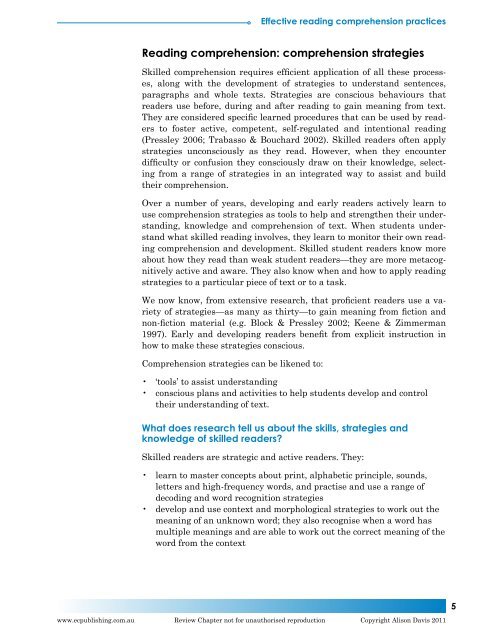Chapter 1: Effective reading comprehension practices (PDF)
Chapter 1: Effective reading comprehension practices (PDF)
Chapter 1: Effective reading comprehension practices (PDF)
You also want an ePaper? Increase the reach of your titles
YUMPU automatically turns print PDFs into web optimized ePapers that Google loves.
<strong>Effective</strong> <strong>reading</strong> <strong>comprehension</strong> <strong>practices</strong>Reading <strong>comprehension</strong>: <strong>comprehension</strong> strategiesSkilled <strong>comprehension</strong> requires efficient application of all these processes,along with the development of strategies to understand sentences,paragraphs and whole texts. Strategies are conscious behaviours thatreaders use before, during and after <strong>reading</strong> to gain meaning from text.They are considered specific learned procedures that can be used by readersto foster active, competent, self-regulated and intentional <strong>reading</strong>(Pressley 2006; Trabasso & Bouchard 2002). Skilled readers often applystrategies unconsciously as they read. However, when they encounterdifficulty or confusion they consciously draw on their knowledge, selectingfrom a range of strategies in an integrated way to assist and buildtheir <strong>comprehension</strong>.Over a number of years, developing and early readers actively learn touse <strong>comprehension</strong> strategies as tools to help and strengthen their understanding,knowledge and <strong>comprehension</strong> of text. When students understandwhat skilled <strong>reading</strong> involves, they learn to monitor their own <strong>reading</strong><strong>comprehension</strong> and development. Skilled student readers know moreabout how they read than weak student readers—they are more metacognitivelyactive and aware. They also know when and how to apply <strong>reading</strong>strategies to a particular piece of text or to a task.We now know, from extensive research, that proficient readers use a varietyof strategies—as many as thirty—to gain meaning from fiction andnon-fiction material (e.g. Block & Pressley 2002; Keene & Zimmerman1997). Early and developing readers benefit from explicit instruction inhow to make these strategies conscious.Comprehension strategies can be likened to:• ‘tools’ to assist understanding• conscious plans and activities to help students develop and controltheir understanding of text.What does research tell us about the skills, strategies andknowledge of skilled readers?Skilled readers are strategic and active readers. They:• learn to master concepts about print, alphabetic principle, sounds,letters and high-frequency words, and practise and use a range ofdecoding and word recognition strategies• develop and use context and morphological strategies to work out themeaning of an unknown word; they also recognise when a word hasmultiple meanings and are able to work out the correct meaning of theword from the context5www.ecpublishing.com.au Review <strong>Chapter</strong> not for unauthorised reproduction Copyright Alison Davis 2011


